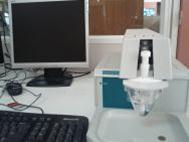





Environmental radioactivity






Instrumentation
The radioactivity measurements which can be performed in Ioannina cover a broad spectrum of equipment and techniques:
Alpha activity measurements:
1 Alpha activity can be measured in samples with alpha spectroscopy with silicon surface barrier detectors in vacuum. With the application of special techniques the MDL can be lowered. For example, when measuring the radium content in water, radium is first absorbed in MnO2, which subsequently is measured by α spectroscopy.

2 Total alpha activity can be measured by a Canberra proportional gas counter

3 Also total alpha activity plus radon and radium concentrations can be measured using the Tricarb Liquid Scintillation Counting System (Tricarb LSA 3170 TR/SL). Uranium and thorium can be measured using an anodic stripping voltammetry system


Beta activity measurements:
4 Total beta activity can be measured by the Canberra proportional gas counter
5 Total beta activity plus tritium and carbon 14 can be measured using can be
measured using the Tricarb Liquid Scintillation Counting System (Tricarb LSA
3170 TR/SL).
At this point our recent work on the rapid screening of 90Sr activity in water
and milk samples using Cherenkov radiation should be mentioned. As it is
known, preceding the measurement of radiostrontium in samples, a long process
of radiochemistry is needed. The application of our method saves greatly the time
of sample preparation, so the screening of a large number of samples is
facilitated.
Also the measurements of tritium in Greece are rather scarce due to lack of
suitable equipment. The measurements of tritium in our laboratories can be
applied in Hydrology and Meteorology. The assessment of tritium concentration
in rainwater is of importance because it can be used for hydrology investigations
such as the recharge mode or the vulnerability of aquifers. We have the capability
of enriching our samples in tritium. Enrichment is accomplished by electrolysis
and lowers the MDL.

Radon measurements:
6 Gamma activity concentrations in air can be measured using high volume air samplers using glass fiber filters, which then are measured by gamma spectroscopy.
7 Three gamma spectroscopy systems using Ge and NaI detectors are on operation.
7 Three gamma spectroscopy systems using Ge and NaI detectors are on operation.


Our Radon Group has been engaged in radon research in various fields, including indoor and outdoor radon surveys, radon studies in the Laboratory, radon and earthquake prediction, radon and geological applications.
Radon measurements are performed using both passive and continuous monitoring techniques, such as: Solid state nuclear track detectors, electret detectors and semiconductor detectors. Our recent work includes the development of computer codes to automatically measure the alpha track surface density in exposed CR39 detectors and cheap monitoring systems based on PIN diodes. These were tested in a multitude of applications, including the monitoring of radon in the indoors environment, the exploration of geological faults and the study of earthquake precursor phenomena.
More on our radon work can be found HERE
Gamma activity measurements:
















